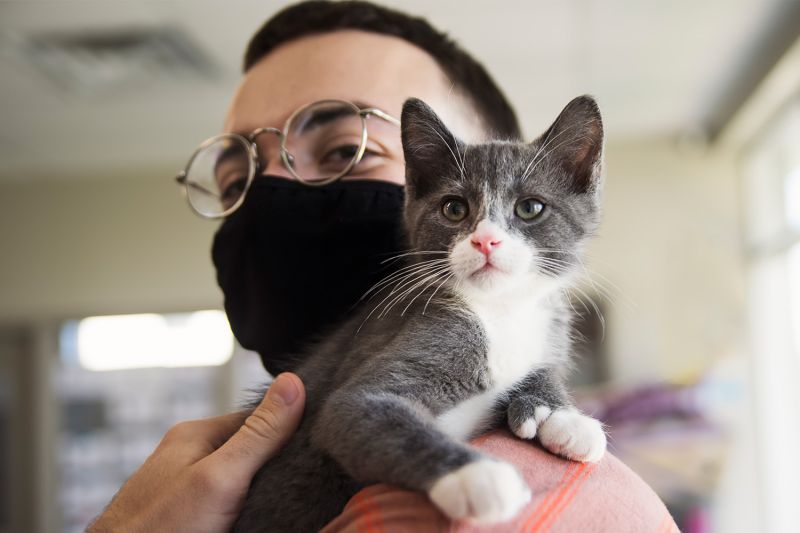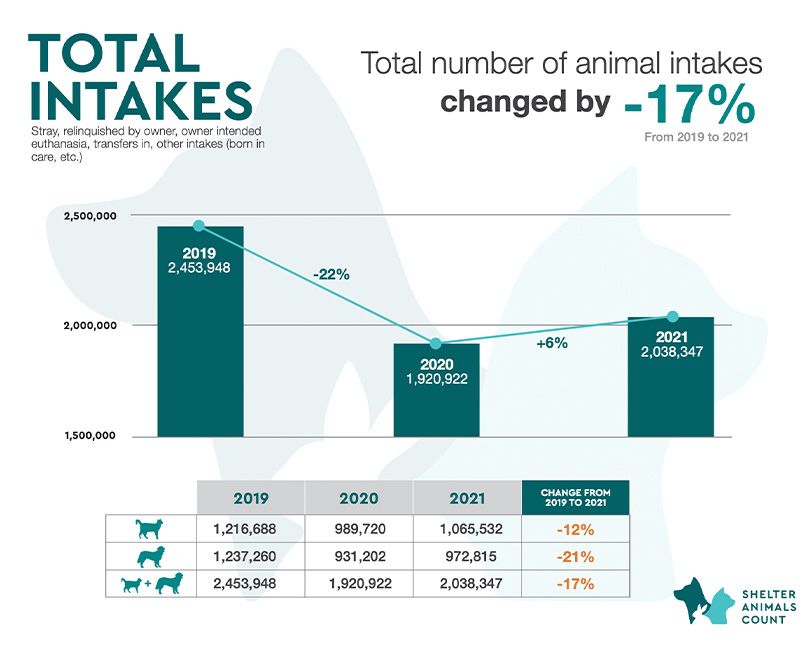Fact check: Were pets adopted during the pandemic returned in large numbers?
Examining the claims about ‘pandemic pets’ and their owners

Our fact-checking series examines common beliefs, often spread by the media, related to the animal sheltering field. Learn how we check facts and find more articles in this series.
Background: In 2020, as people were stuck inside due to COVID-19 pandemic restrictions, some shelters and rescues saw a surge in animal adoptions. Media articles celebrated this as a feel-good story during a time of incredible difficulty.
In 2021, news stories took a different tone and started reporting that these “pandemic pets” were now being returned to shelters and rescues. A lot of the sentiment centered around how people were going back into the office or were planning vacations and no longer wanted their animals, creating a narrative that adopters were flippant and selfish.
What the data reveals: Although some shelters and rescues experienced a surge in adoptions in 2020, data from Shelter Animals Count shows that the number of adoptions nationwide declined 17% compared to 2019. The following year, adoptions increased slightly but were still below 2019 levels. The reason many shelters experienced empty kennels during this time period was that fewer animals, particularly lost pets, were entering shelters, says Lindsay Hamrick, director of shelter outreach and engagement at Humane World for Animals.
Data also doesn’t show increased relinquishments since the start of the pandemic. A Shelter Animals Count report comparing sheltering data from 1,233 U.S. organizations between 2019 and 2021 found the number of relinquished animals was the highest in 2019 followed by 2021. A separate Shelter Animals Count report found that owner-relinquished animals (as a proportion of total shelter intakes) remained consistent at 25% between 2019 and 2022.

A 2021 study of 10,044 U.S. residents found that the survey population acquired 1,674 cats and dogs during the pandemic. Of those who acquired a dog, 90% still had their animal, as did 87% of those who acquired a cat. The authors stated that “while these findings indicate that pets were not being rehomed in massive numbers, the percentages of animals that were rehomed may be larger than is typical during economically stable times.” The study found that many factors influenced people’s decision to rehome their pets and that most people rehomed their animals directly to friends or family members rather than relinquishing them to shelters.
On overall shelter intakes, the 2022 Shelter Animals Count analysis states: “The number of animals entering shelters continues to slightly increase each year since the pandemic, but is still 16% less than 2019.” In 2022, 4% more animals entered shelters than left, up from 2% in 2021. (Note that the data only included cats and dogs; many shelters and rescues have reported a significant increase in small pet intakes over the past few years.)
As for why people surrender their pets, a 2022 study of almost 4,000 pet owners from several different countries found that financial restraints was the most cited reason for relinquishing or considering relinquishing a pet, followed by health concerns related to COVID-19. Most people who relinquished a pet gave the animal directly to someone they knew; only 14.3% relinquished their pet to a shelter.

Conclusions: Decades of research shows that housing insecurity and financial restraints are among the most common reasons people relinquish pets. When stories of people giving up “pandemic pets” began circulating, economic hardships—such as inflation, job losses and lack of affordable housing—were intensifying.
Some experts also attribute recent increases in shelter intakes to the reduction in low- and no-cost spay/neuter services during the pandemic. A 2022 study estimated that reduced spay/neuter capacity during the pandemic resulted in a deficit of 2.7 million spay/neuter surgeries by the end of 2021.
While there’s some evidence in the 2021 study that people who acquired an animal during the pandemic were more likely to relinquish their pet, the heart of the myth comes from the assumption that people began frivolously getting rid of their pets once they were no longer stuck at home. The broader truth is that people have been struggling with job losses caused by the pandemic, health issues, housing insecurity, rising costs of goods and other constraints, Hamrick says.
It's important to note that one limitation in studying pet relinquishment is that pet owners may be hesitant to give the true reason for relinquishment due to feelings of shame or fears of being judged. Another limitation involves shelter software and inconsistent data collection. As the authors of a 2023 study state: “The circumstances that lead to pet relinquishment are often multifaceted,” but many shelter software systems only allow staff to select a single reason. In the same study, 81 staff members from U.S. and Canadian animal shelters were presented with four identical pet surrender scenarios yet varied widely in their identification of a primary surrender reason.
To improve data collection, Shelter Animals Count is working to standardize definitions related to pet surrender. Currently, the SAC database provides macro-level data on shelter animal intakes and outcomes. In the future, it plans to expand its platform to provide animal-level data, including factors such as age, size and reasons for surrender. These efforts will enable our field to gain a fuller understanding of the reasons owners surrender pets so we can develop more effective programs to keep pets with their families, says Hamrick.
Reviewed by Dr. Grace Carroll, Queen’s University Belfast; Samantha Hill, Shelter Animals Count; Dr. Margaret Slater, ASPCA; Melissa Thibault, ASPCA.







